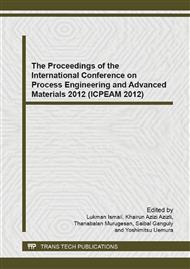[1]
CCPS, Guidelines for Preventing Human Error in Process Safety. American Institute of Chemical Engineers, New York (1994).
Google Scholar
[2]
T.A. Kletz, Cheaper, safer plants, or wealth and safety at work. Rugby: Institution of Chemical Engineers (1984).
Google Scholar
[3]
INSIDE Project, Inherent SHE: The cost effective route to improved safety, health and environmental performance, London, London, UK: IBC UK Conferences Limited June 16-17 (1997).
Google Scholar
[4]
R.W. French, D.D. Williams, and E.D. Wixom, Inherent safety, health, and environmental (SHE) reviews. Process Safety Progress, 15: 48–51. doi: 10. 1002/prs. 680150112 (1996).
DOI: 10.1002/prs.680150112
Google Scholar
[5]
D.C. Hendershot, Design of inherently safer chemical processing facilities, presented at Texas Chemical Council Safety Seminar, June 11, Galveston, TX, Session D (1991).
Google Scholar
[6]
S.A. Berger, and R.J. Lantzy, Reducing inherent risk through consequence modelling, In H. Cullingford (Ed. ), Process Plant Safety Symposium, Volume 1, April 1-2, Houston, TX (pp.15-23). Houston, TX: South Texas Section of the American Institute of Chemical Engineers (1996).
Google Scholar
[7]
F.I. Khan, and P.R. Amyotte, Integrated inherent safety index (I2SI): a tool for inherent safety evaluation, Process Safety Progress 23 (2) (2004) 136–148.
DOI: 10.1002/prs.10015
Google Scholar
[8]
F.I. Khan, and P.R. Amyotte, I2SI: a comprehensive quantitative tool for inherent safety and cost evaluation, Journal of Loss Prevention in the Process Industries 15, (2005) 279–289 (Elsevier Science Ltd. ).
DOI: 10.1016/j.jlp.2005.06.022
Google Scholar
[9]
A. Tugnoli, and V. Cozzani, A consequence based approach to the quantitative assessment of inherent safety, AIChE Journal AIChE 53 (2), (2008) 3171–3181 (Wiley InterScience).
DOI: 10.1002/aic.11315
Google Scholar
[10]
A. Mohd Shariff, R. Rusli, T.L. Chan, V.R. Radhakrishnan, A. Buang, Inherent Safety Tool For Explosion Consequences Study, Journal of Loss Prevention in the Process Industries 19 (2006) pp.409-418.
DOI: 10.1016/j.jlp.2005.10.008
Google Scholar
[11]
C.T. Leong, and A. Mohd Shariff, Inherent Safety Index Module (ISIM) to Asses Inherent Safety Level during Preliminary Design Stage, Process Safety and Environmental Protection, Vol 86 (2008), 113 – 119.
DOI: 10.1016/j.psep.2007.10.016
Google Scholar
[12]
C.T. Leong, and A. Mohd Shariff, Process Route Index (PRI) to Assess Level of Explosiveness for Inherent Safety Quantification, Journal of Loss Prevention in Process Industries, 22: (2009) 216-221.
DOI: 10.1016/j.jlp.2008.12.008
Google Scholar
[13]
A.M. Shariff, and C.T. Leong, Inherent Risk Assessment – A new concept to evaluate risk in preliminary design stage, Process Safety and Environmental Protection, doi: 10. 1016/j. PSEP. 2009. 08. 004 (2009).
DOI: 10.1016/j.psep.2009.08.004
Google Scholar
[14]
R. Rusli, and A. Mohd Shariff, Qualitative assessment for inherently safer design (QAISD) at preliminary design stage, Journal of Loss Prevention in Process Industries, 22 (2009), 1-9.
DOI: 10.1016/j.jlp.2009.07.005
Google Scholar
[15]
A.M. Shariff, and D. Zaini, Toxic release consequence analysis tool (TORCAT) for inherently safer design plant. Journal of Hazardous Materials 182, (2010) pp.394-402.
DOI: 10.1016/j.jhazmat.2010.06.046
Google Scholar
[16]
T.L. Saaty, The analytic hierarchy process. New York: McGraw-Hill (1980).
Google Scholar
[17]
H. Deng, Multicriteria analysis with fuzzy pair-wise comparison. International Journal of Approximate Reasoning, 21, (1999) pp.215-231.
DOI: 10.1016/s0888-613x(99)00025-0
Google Scholar
[18]
C. Kahraman, U. Cecebi, and Z. Ulukan, Multi-criteria supplier selection using Fuzzy AHP. Logistics Information Management, 16 (6), (2003) pp.382-394.
DOI: 10.1108/09576050310503367
Google Scholar
[19]
T.C. Wang, and Y.H. Chen, Y.H., Applying consistent fuzzy preference relations to partnership selection. Omega, the International Journal of Management Science, 35, (2007) pp.384-388.
DOI: 10.1016/j.omega.2005.07.007
Google Scholar
[20]
A.N. Paralikas, and A.I. Lygeros, A Multi-Criteria and Fuzzy Logic Based Methodology for the Relative Ranking of the Fire Hazard of Chemical Substances and Installations. Process Safety and Environmental Protection, 83(B2), (2005) p.122–134.
DOI: 10.1205/psep.04236
Google Scholar
[21]
Z. Ma, L. Sylla, D. Xiong, and X. Zhang, Fuzzy Ranking Methodology for Risk Assessment of Potential Pollution Accidents in Chemical Plants. 4th International Conference on Bioinformatics and Biomedical Engineering (iCBBE), (2010) pp.1-4.
DOI: 10.1109/icbbe.2010.5518075
Google Scholar
[22]
G. Zheng, N. Zhu, Z. Tian, Y. Chen, and B. Sun, Application of a Trapezoidal Fuzzy AHP Method for Work Safety Evaluation and Early Warning Rating of Hot and Humid Environments. Safety Science, 50, (2012) pp.228-239.
DOI: 10.1016/j.ssci.2011.08.042
Google Scholar
[23]
T.Y. Hsieh, S.T. Lu, and G.H. Tzeng, Fuzzy MCDM approach for planning and design tenders selection in public office buildings. International Journal of Project Management, Vol. 22, (2004) pp.573-584.
DOI: 10.1016/j.ijproman.2004.01.002
Google Scholar
[24]
S.K. Lee, G. Mogi, J.W. Kim, and B.J. Gim, A Fuzzy Analytic Hierarchy Process Approach for Assessing National Competitiveness in the Hydrogen Technology Sector. International Journal of Hydrogen Energy, 33, (2008) pp.6840-6848.
DOI: 10.1016/j.ijhydene.2008.09.028
Google Scholar
[25]
Q. Hao, C. Fan, L. Pingying, and S.T. Li, Architectural Design Porposals Selection Based on Fuzzy Analytic Hierarchy Process. International Conference on Industrial Engineering and Engineering Management, IEEM. pp.2266-2270 (2009).
DOI: 10.1109/ieem.2009.5373058
Google Scholar
[26]
M.Z. Naghadehi, R. Mikaeil, and M. Ataei, The application of fuzzy hierarchy process (FAHP) approach to selection of optimum underground mining method for Jajarm Bauxite Mine, Iran. Expert Systems with Applications 36, (2009) pp.8218-8226.
DOI: 10.1016/j.eswa.2008.10.006
Google Scholar
[27]
C. Ozan, and S.C. Mustafa, A web-based decision support system for multi-criteria inventory classification using fuzzy AHP methodology. Expert systems with applications, Vol. 35, No. 3, (2008) pp.1367-1378.
DOI: 10.1016/j.eswa.2007.08.041
Google Scholar
[28]
F. Kong, Fuzzy multiple attribute decision making theory, method and its application. Beijing: China Agricultural Science and Technology Press, (2008) pp.62-63.
Google Scholar
[29]
L.S. Thomas, Modeling unstructured decision problems – the theory of analytical hierarchies. Mathematics and Computers in Simulation, Vol. 20, No. 3, (1978) pp.147-158.
DOI: 10.1016/0378-4754(78)90064-2
Google Scholar
[30]
J.J. Buckley, Fuzzy hierarchical analysis. Fuzzy sets and systems, Vol. 17, (1985) pp.407-409.
Google Scholar
[31]
J. Ren, I. Jenkinson, J. Wang, D.L. Xu, and J.B. Yang, A methodology to model causal relationships on offshore safety assessment focusing on human and organizational factors. Journal of Safety Research, 39, (2008) pp.87-100.
DOI: 10.1016/j.jsr.2007.09.009
Google Scholar


